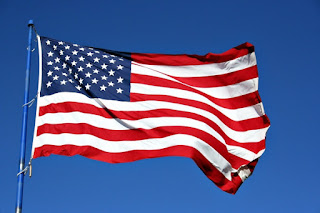This past Saturday, I attended my first ever American Flag Retirement Ceremony hosted by the Daughters of the American Revolution. I had often wondered about what to do with an American flag when it is no longer serviceable. Since many other Americans may also wonder, I thought I would share how Saturday's ceremony went.
When we fly an American flag, it should be clean and without wear and tear. Once the flag shows sign of weathering or is soiled, it should be respectfully retired by burning. But how is a flag prepared for retirement?
RETIRING THE AMERICAN FLAG
Reminder: At no time should the American flag touch the ground.
1. Using scissors, remove the star field from the flag.
2. Continue to cut each stripe one by one. Each stripe may represent one of the original 13 colonies.
3. Each stripe should be taken and placed respectfully on the fire.
4. Once each of the stripes has been placed in the fire, the field of stars is added.
No fire should be left unattended. Our ceremony took place at the local fire department.
A CEREMONY OF RESPECT
Saturday's Flag Retirement Ceremony began with the DAR Regent recognizing the local Boy Scout Troop acting as Color Guard. After we sang the National Anthem, the colors were posted by the Boy Scouts.
The DAR Regent reminded those in attendance that the flag ceremony is not a celebration but a solemn ritual held in respect for out Nation's flag and the service she performs. "The Flag of the United States of America is our Nation's symbol of liberty... It speaks our sense of pride as proud Americans."
On a nearby table were several donated flags prepared for retirement. As described above, each of the flags had been disassembled and their matching colors were placed together. The Regent read the names and admission dates of the original 13 states as each stripe was placed on the fire.
Stripe 1: Delaware - December 7, 1787
Stripe 2: Pennsylvania - December 12, 1787
Stripe 3: New Jersey - December 18, 1787
Stripe 4: Georgia - January 2, 1788
Stripe 5: Connecticut - January 9, 1788
Stripe 6: Massachusetts - February 6, 1788
Stripe 7: Maryland - April 28, 1788
Stripe 8: South Carolina - May 23, 1788
Stripe 9: New Hampshire - June 21, 1788
Stripe 10: Virginia - June 25, 1788
Stripe 11: New York - July 26, 1788
Stripe 12: North Carolina - November 21, 1788
Stripe 13: Rhode Island - May 29, 1790
One flag remained in tact and was disassembled as the ceremony continued with each stripe making its way to the fire with the matching stripes being presented.
The DAR Regent continued, "Old Glory, we give you to the flames, and to the ground from which you came... We look at last on stars once pure and pray their spirit long endures. To keep our children forever free, to light within Fire's Liberty!"
With the final field of stars placed in the fire, the Regent stated, "Nothing is really ended until it is forgotten. Our Flag, the symbol of freedom for millions of citizens of our great land and the banner under which countless numbers have given their last measure of devotion in wars to protect our freedom, will never be forgotten."
Before the colors were retired, the Pledge of Allegiance was recited by all in attendance.
I pledge allegiance to the flag of the United States of America and to the Republic for which it stands, one Nation under God, indivisible, with liberty and justice for all.
We concluded the meeting by singing God Bless America.
The meeting was less than an hour and was a very solemn experience. I was raised in a very patriotic home, and to this day I tear up hearing the national anthem. I went to this Flag Retirement Ceremony curious as to how our nation's flag is treated when her journey comes to an end. It was dignified and extremely respectful. We must remember that when the flag is disassembled, it is no longer a flag. So, we should not look upon this as a disrespectful act of flag burning, but instead, a moment in which we can pay our respects to a symbol of our freedom as she is retired from her term of service.



No comments:
Post a Comment